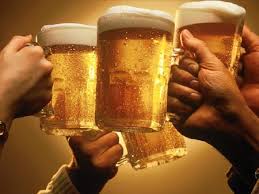Le présent article a été rédigé par Jacquie Bridonneau, que je remercie. Une traduction en français sera publiée ultérieurement.
Generally, people who hear the name of the city, Milwaukee, think of one of two things: either Harley Davidson motorcycles (founded in the first decade of the 20th century and whose headquarters are still located in Milwaukee) or beer. But when you drive into Milwaukee, even before actually arriving in the city, if you have your windows open, your nose will definitely orient you on the way to go: the smell of hops, barley and beer being brewed is tangible and hangs heavily in the air for miles around.
So is there only one “beer that made Milwaukee famous?” And why Milwaukee?
Milwaukee was or is the hometown to a host of breweries, selling either on a national level or niche breweries, for specialized beers that can usually only be purchased locally. The MillerCoors brewery is one of the largest in the world, with the flagship brand, Miller Lite, but also Coors Lite, which could previously only be found near the Rocky mountains, as many lesser known brands such as Icehouse, Keystone and Hamms. Miller High Life, another mythical brand, known as the “Champagne of beers” is also still holding its own, with a reputation of a great beer at an honest price, thus enabling more people to “live the High Life.”
Schlitz, the orginal “beer that made Milwaukee famous” is also still brewed, though it is no longer a household name like it was a generation or two ago. In fact the Schlitz managers were marketing geniuses, and a lot could be learned by having a quick glimpse at their brand strategy. Way back in the 1930’s they had their own unique little brown bottle called a “Stienie” designed not to take up precious space in a fridge or ice-box. Schlitz beer was also enriched with “Sunshine Vitamin D,” giving beer drinkers the impression at least that they doing a bit for their own health when they had a beer. And last but certainly not least, Schlitz was one of the first brands to introduce a slight sexual inuendo at a time when things like that were still taboo in the US with their ingenious tag-line, “Just The Kiss Of The Hops” meaning that your beer would be light without any bitter aftertaste.
Some other lesser known breweries in Milwaukee include the Rock Bottom Restaurant and Brewery, the 2nd Street Brewery, Lakefront Brewery, Stonefly Brewery, Leinenkugel Brewing Co, and the Horney Goat Brewing Company.
Milwaukee is a good, hard-working city, with strong German origins, and Germans from the “Old Country” were at the origin of all these great beers. In the 1850s there were about twenty-five breweries in Milwaukee, all German owned and operated. But Milwaukee was still a small city back then, and most of these breweries are not around now. We can say that Milwaukee came to be known as the beer capital of the world because of a combination of different factors. Cheap ice from Lake Michigan favored cooling before refrigerators were everyday items. Kegs or barrels were also not costly because of the large timber industry in Wisconsin. But first and foremost, as Milwaukee was a relatively small city, brewers were forced to look beyond the borders to find customers, and quickly developed what now is known as a global business strategy.
The proximity with Chicago was also favorable for promoting the beer making industry in Milwaukee, with cheap and easy transportation. The Great Chicago Fire of 1871, where Chicago breweries were burned down, and free kegs of beer donated, also did its part in boosting sales of Milwaukee beer, and contributing to the fame of this city.
And finally, as we have seen, especially in the Schlitz advertisements, Milwaukee brewers were a bunch of savvy businessmen and aggressive industrialists. So next time you are sipping a beer on a hot summer day, just like they do in Milwaukee, raise your glass and say “Prost ” or “Prosit.”

.jpg)
Aucun commentaire:
Enregistrer un commentaire